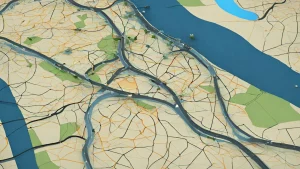Political Research
At Geospatial, we offer specialized GIS services for political research, including opposition research, spatial data visualization, and voter analysis. We help campaigns make informed decisions by analyzing complex spatial data of rival candidates’ background, record, political support, fundraising base, voting record, and policy positions using GIS technology. Contact us for support in your political research needs.
One way that GIS might be used in this context is to help visualize and analyze the candidate’s political support and fundraising base. For example, you might use GIS to map out the locations of the candidate’s campaign donors, identifying any patterns or clusters of support. You could also use GIS to analyze demographic data about the candidate’s supporters, such as their age, income, and education level, in order to better understand the candidate’s base of support.
Additionally, you could use GIS to analyze the candidate’s voting record and policy positions, looking for any inconsistencies or areas of potential vulnerability. For example, you might use GIS to map out the locations of key industries or groups that are impacted by the candidate’s policy positions, and compare this to the candidate’s voting record or public statements. This can help you identify any potential inconsistencies or areas of tension that could be used to attack the candidate’s credibility.
Overall, GIS can be a powerful tool for political opposition research, allowing campaigns to gather and analyze complex spatial data and visualize the results in a meaningful way. By using GIS to identify patterns, trends, and inconsistencies in the data, campaigns can make more informed and practical decisions about how to position their own candidates and attack their rivals.

WHAT ARE THE ADVANTAGES?
- Visualizing and analyzing candidate support:
GIS can indeed be used to map out the locations of campaign donors and analyze demographic data to understand a candidate’s support base.
- Analyzing voting records and policy positions:
GIS can help identify inconsistencies or vulnerabilities in a candidate’s voting record or policy positions by mapping out relevant data such as industry locations impacted by policies.
- Advantages of GIS in political research:
The advantages listed, including visualizing large amounts of data, facilitating spatial analysis, supporting data-driven decision-making, and providing a competitive advantage, are all valid points.
- Political research examples:
The examples provided demonstrate how GIS can be used to analyze school achievement, economic conditions, and real estate holdings in a specific congressional district to inform political campaign strategies effectively.
Political Research EXAMPLES
Use GIS to map a congressional district by school district and overlay data on test scores, graduation rates, and student demographics to identify areas with low achievement.
Map the district by census block and overlay data on unemployment rates, median household income, and job growth to pinpoint areas with economic challenges.
Conduct an analysis of top candidates’ real estate holdings in the district, identifying properties owned, their value, and location to tailor campaign messages accordingly.
Utilize credible sources like CoreLogic, Zillow, or CoStar Group for real estate data, which can be licensed or purchased for analysis using GIS software.


